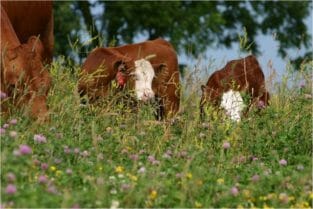Can farmers make a living while caring for the land, soil and water?
Earlier this month I attended Iowa Environmental Council’s annual conference. This year’s theme was ECOnomics. During one session, speakers talked about the benefits and challenges of trying to make a living that sustains land, water, families and rural communities.
 One speaker was Practical Farmers member Seth Watkins. Seth is the fourth generation farming his family’s 1846-founded heritage farm near Clarinda. Seth operates a 600-head cow-calf enterprise, raises hay and corn for cattle feed, and implements a multitude of conservation practices.
One speaker was Practical Farmers member Seth Watkins. Seth is the fourth generation farming his family’s 1846-founded heritage farm near Clarinda. Seth operates a 600-head cow-calf enterprise, raises hay and corn for cattle feed, and implements a multitude of conservation practices.
Seth started his presentation with: “Can farmers make a living while caring for their land, soil and water? Yes, absolutely. I am a farmer. I get money from the government. You all contributed to that. At the very least, I owe you clean water and healthy soil.”
Seth returned to his family farm in 1994, and 1998 was a pivotal year. He was attempting to help a cow birth a calf in midst of a late-winter blizzard. “I asked myself: Why am I working against Mother Nature instead of with her? Baby calves aren’t supposed to be born in cold rotten weather! They deserve to be born on lush spring days.” At that point, Seth decided, “My focus would be on having clean water, healthy soil, and happy cows. If I went broke, so be it. I’d be able to sleep at night knowing I’d done right by the cows and the land.” Seth started by moving his calving season from February to early April. With this simple change in management, something pleasantly unexpected happened. Seth said: “When I stopped focusing on production, my production increased and my profits went up.”
Seth continued, “Making a happy cow is a wonderful system and I have added several practices over the last 18 years to enhance my system. We have moved to integrated pest management for weed control. We have inter-seeded clover in the pastures to reduce our need for commercial nitrogen. We continue to improve our grazing system and water quality. Decreased reliance on finite resources contribute to greater herd health, production, and about a $300 increase in revenue per calf over our old system.”
 “This isn’t hippy stuff, it’s economic logic. I took what I learned about conservation in my livestock system and applied it to my crops. The cost of fossil fuels, iron and other finite resources we use to farm increase at a higher inflation rate than the price we receive for the products we sell.” Practices Seth has implemented in his cropping systems include no-till, crop rotation of 3+ species, cover crops, integrating livestock into crop fields for feed and fertility. He has seen an $85/acre increase in profit. Seth said, “These practices have increased the resilience of my farm by improving the soil and its ability to sequester carbon and infiltrate water. This resilience has allowed me to plant and harvest in a timelier manner. Finally, I have been able to improve my return on investment by identifying and not farming poor-producing acres. These acres can be enhanced for wildlife to provide revenue from outfitting.”
“This isn’t hippy stuff, it’s economic logic. I took what I learned about conservation in my livestock system and applied it to my crops. The cost of fossil fuels, iron and other finite resources we use to farm increase at a higher inflation rate than the price we receive for the products we sell.” Practices Seth has implemented in his cropping systems include no-till, crop rotation of 3+ species, cover crops, integrating livestock into crop fields for feed and fertility. He has seen an $85/acre increase in profit. Seth said, “These practices have increased the resilience of my farm by improving the soil and its ability to sequester carbon and infiltrate water. This resilience has allowed me to plant and harvest in a timelier manner. Finally, I have been able to improve my return on investment by identifying and not farming poor-producing acres. These acres can be enhanced for wildlife to provide revenue from outfitting.”
Other conservation practices Seth employs at his Pinhook Farm include: rotational grazing, restricted wildlife areas, riparian buffers, ponds, shallow water habitats, prescribed burning, windbreak restoration, terraces, inter-seeded legumes, prairie restoration/CRP and row crops integrated with prairie strips. Seth said, “When we reduced our use of chemicals all sorts of wonderful things started to happen. First the forbs, flowers, & clover started to reappear, and then came more birds, pollinators and wildlife. These all support our outfitting and land mitigation businesses. These enterprises now account for about 25% of my net income.”
Are you making money while protecting the environment? Is the possibility of both profit and environmental stewardship possible for the majority of farmers? Please email me at sally@practicalfarmers.org and share your thoughts.
Click here for Seth’s PowerPoint from the Iowa Environmental Council Conference.
Read more about Seth’s system thinking in his article on page 8 of Getting Into Soil & Water 2016 here.
